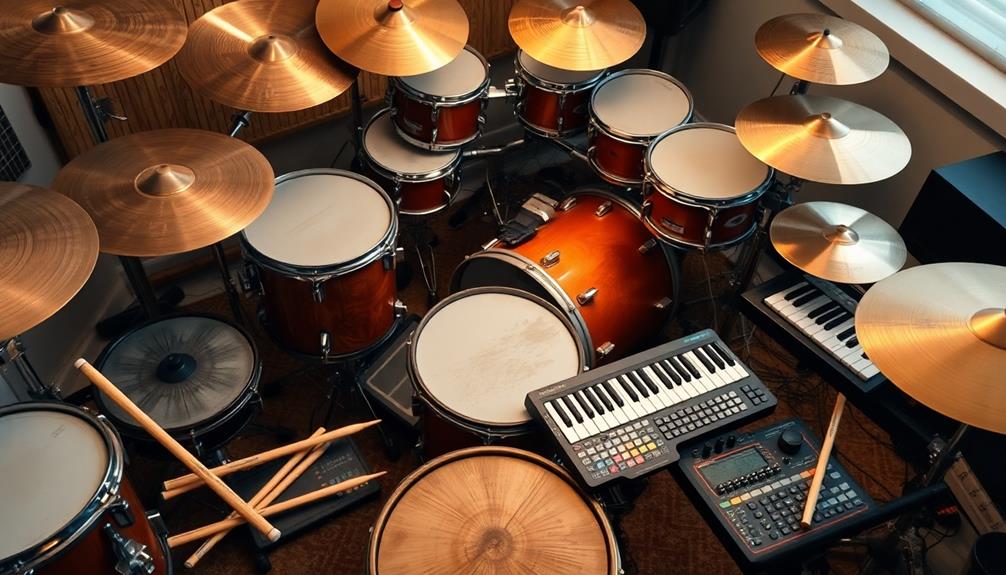To mix trap beats effectively, start by blending your kick and 808 for a punchy, deep sound. Use saturation for warmth and side-chain compression to allow the kick to cut through. Enhance snares with compression and a little reverb for thickness. Manage your frequency by cutting below 30Hz on the 808 and using high-pass filters on other tracks. Set levels to maintain headroom, ideally around -10dB. Experiment with panning and stereo widening to create depth. Stick with these strategies, and you'll lock in that signature trap sound; there's so much more to explore on this journey.
Key Takeaways
- Blend kick and 808 using side-chain compression to maintain clarity and punch in the low end.
- Apply aggressive EQ to enhance trap snares, boosting high frequencies for brightness without overcrowding.
- Utilize a drum bus for cohesive processing, applying compression and clipping for added energy and impact.
- Monitor frequency management by cutting low frequencies on non-bass instruments to prevent muddiness in the mix.
- Experiment with panning and stereo imaging to enhance clarity and spatial quality while avoiding phase cancellation issues.
Mixing Kick and 808
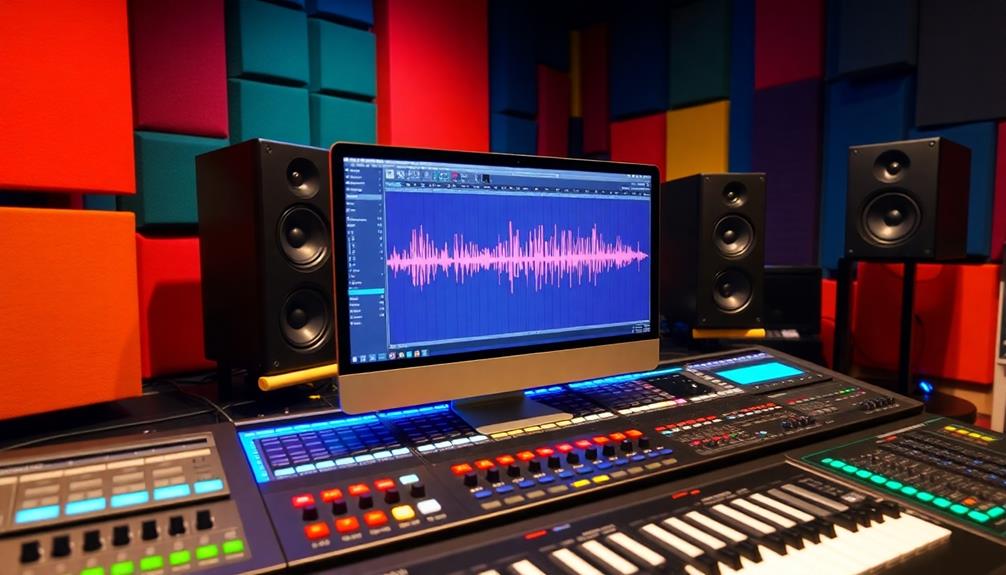
Mixing kick and 808 is crucial for achieving that signature trap sound. To create a balanced sound, you need to blend the kick drum's punch with the 808's deep bass.
Start by using a saturation plugin to enhance the 808's harmonics, adding warmth without overpowering the kick. This way, the low-end presence of the kick is emphasized while the 808 fills in the bass frequencies.
Next, apply side-chain compression. This technique allows the kick to control the dynamics of the 808, guaranteeing that the kick hits punchily while the 808 supports the low-end.
When adjusting EQ, cut the low frequencies of the 808 below 30Hz to avoid muddiness, creating space for the kick around 60Hz.
For width, use a single mono 808 track with a duplicated stereo version, slightly detuning the duplicates for added spatial effects. Always monitor in mono to prevent phase issues.
Enhancing Trap Snares

Crafting the perfect trap snare is all about achieving a punchy and impactful sound that cuts through the mix. To enhance your trap snares, start by applying an 1176 compressor. This will help distort transients and boost output harmonics, resulting in a punchier sound that commands attention.
Next, incorporate a short reverb effect to thicken the snare's presence. This adds space and depth without overwhelming your mix sound. You can also experiment with sample delay techniques to position snares in the stereo field. This technique creates a wider and more engaging soundstage, making your snares feel more dynamic.
Don't forget about EQ! Aggressively boost high frequencies around 5-10kHz to add brightness and clarity, allowing your snares to stand out prominently.
Layering multiple snare samples is another effective strategy; make sure that each layer complements the others regarding frequency and dynamics.
Drum Bus Techniques
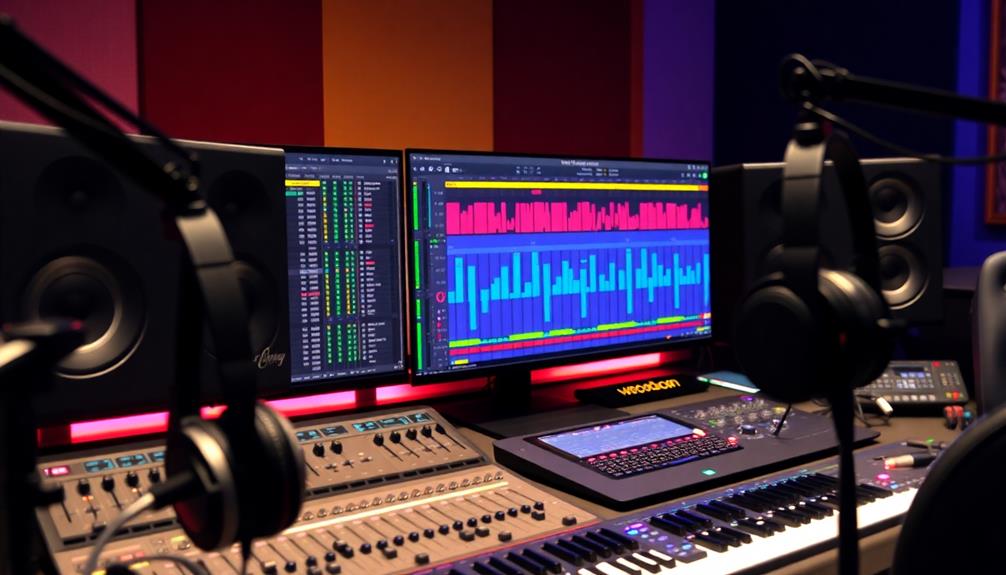
When you want to achieve a cohesive sound for your trap beats, utilizing a drum bus is essential. A drum bus allows you to process all your drum elements together, enhancing the overall punch and clarity of your mix.
Start by applying compression to the drum bus, which helps to tighten the sound and gives it more impact. Consider using M/S (Mid/Side) compression; this technique compresses the mid frequencies more than the sides, resulting in stereo expansion and a wider soundstage.
You can also employ a clipper on the drum bus to add some brightness and white noise, contributing to a punchier, more energetic sound. To add depth, applying a short reverb can thicken your snare and hi-hat sounds, creating a more dynamic rhythm that engages listeners.
Regularly reference your mix before and after processing on the drum bus to highlight the significant improvements in clarity and impact. This practice guarantees you're making intentional choices that elevate your trap beats, keeping everything tight and polished.
With these techniques, you'll have a powerful foundation for your tracks.
Instrument Bus Processing
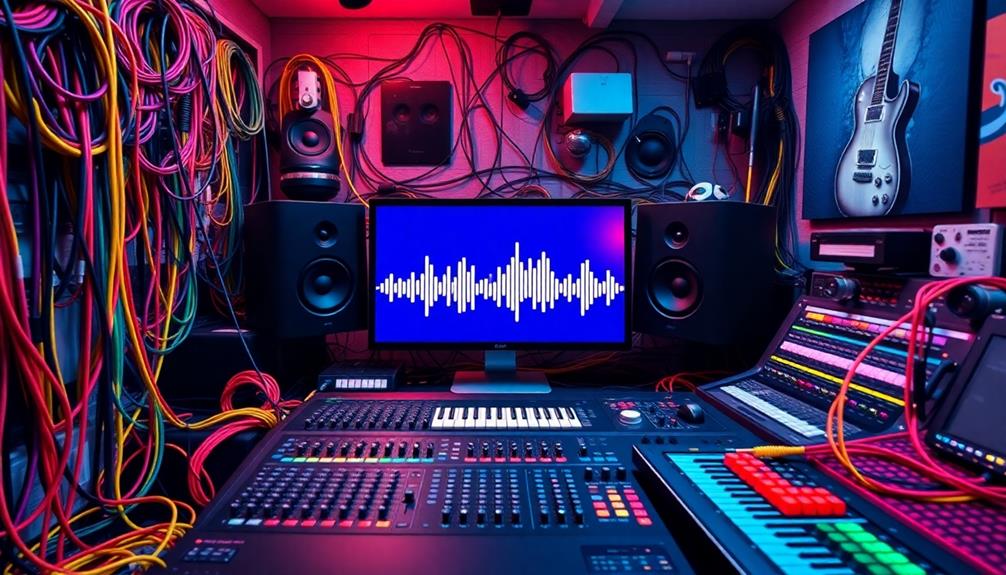
When you're mixing trap beats, instrument bus processing is essential for achieving a polished sound.
You can enhance clarity and presence by using upward compression techniques like MV2, while harmonic saturation tools like PSP Saturator can enrich your mix.
Don't forget to add character with modulation effects from plugins like Vinyl Strip to keep your sound engaging.
Upward Compression Techniques
In the domain of mixing trap beats, upward compression techniques can notably elevate your instrument bus processing. By utilizing upward compression, you can enhance the presence of quieter instrument details without squashing the dynamics too much.
Here are three essential skills to keep in mind when applying this technique:
- Choose Your Ratio Wisely: Aim for a subtle ratio between 2:1 to 4:1 to maintain the natural dynamics while enhancing clarity.
- Monitor Your Mix: Regularly check your mix after applying upward compression to make sure it contributes positively and doesn't lead to muddiness.
- Reduce Masking Issues: Use upward compression to lift lower-level signals, helping each element occupy its own sonic space more effectively.
Incorporating upward compression on your instrument bus can create a fuller and more cohesive sound. By focusing on these elements, you can greatly improve your mix's overall quality and clarity.
Harmonic Saturation Use
Upward compression can set the stage for adding harmonic saturation, which enriches the sound of your instrument bus. This technique helps bring warmth and richness, enhancing the presence of quieter details in your mix. By utilizing plugins like PSP Saturator, you can introduce cohesive harmonics while avoiding aliasing, ensuring a smooth blend of sounds.
Here's a quick overview of the harmonic saturation process:
| Step | Description |
|---|---|
| 1. Upward Compression | Use plugins like MV2 to reveal subtle nuances. |
| 2. Choose Plugins | Select harmonic saturation plugins for warmth. |
| 3. Adjust Drive | Monitor and tweak drive levels for balance. |
| 4. Maintain Headroom | Apply saturation judiciously to prevent distortion. |
Clarity and Modulation
Achieving clarity in your instrument bus processing is essential for a polished trap beat. You want each element to shine without getting lost in the mix. Here are three key techniques to enhance clarity and modulation:
- Upward Compression: Use the MV2 upward compressor on your instrument bus. This brings quieter details forward, enhancing the overall clarity of your mix.
- Harmonic Enrichment: Implement the PSP Saturator to add cohesive harmonics. This technique avoids aliasing while enriching your sound design, giving your trap beats a fuller texture.
- Unique Character: Introduce a Vinyl strip plugin to add LoFi qualities and modulation. This can contribute a distinct character that sets your beats apart.
Always assess your processing choices to maintain balance. Utilize tools like Fresh Air and Gullfoss EQ to reduce masking between elements, ensuring each instrument remains distinguishable.
Regularly check your instrument bus, especially as you add new elements. By focusing on clarity and effective modulation, you'll achieve a more engaging and polished sound in your trap beats.
Don't forget to explore free plugins to expand your options!
Frequency Management

Effective frequency management is vital for creating clean and impactful trap beats. Start by cutting frequencies below 250Hz for non-bass instruments; this helps prevent muddiness and creates space for your kick and 808 bassline. Using high-pass filters on duplicate 808 tracks around 160Hz can further reduce low-end overlap, enhancing clarity in your mix.
Regularly check your mix in mono to guarantee the low frequencies, typically below 300Hz, are balanced and free from phase issues. This step is significant, as phase problems can lead to a weak and unfocused sound.
Additionally, applying a low-pass filter to instrument groups can create much-needed space, especially for elements competing with the kick and bass.
Balancing low-end energy with overall mix clarity is critical. Avoid excessively boosting low-end frequencies, as this can clutter your mix and make it sound unprofessional.
Level Setting Strategies
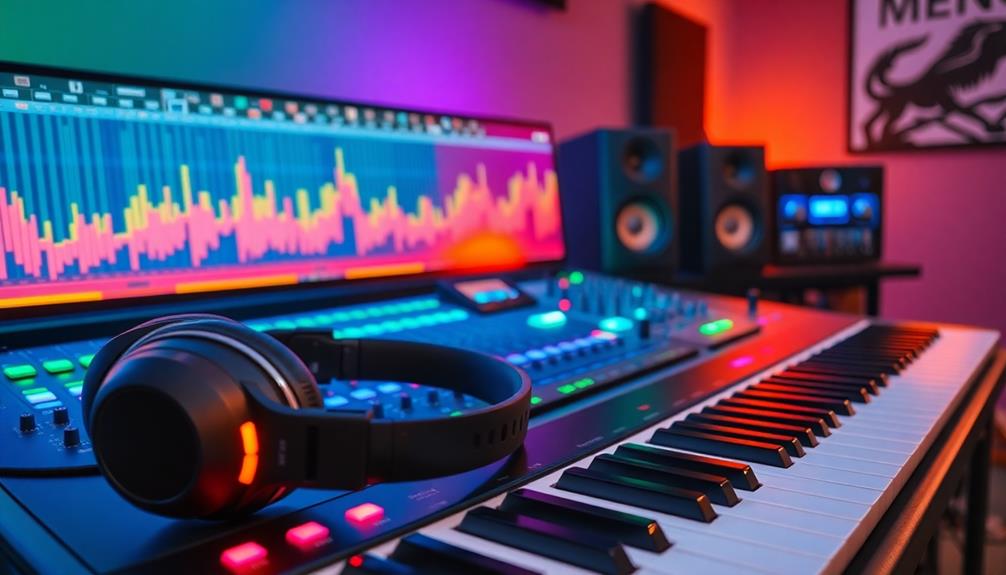
Once you've got your frequency management under control, the next step is to focus on level setting strategies that bring your trap beats to life. Proper level setting guarantees your mix is dynamic while preventing distortion when the track's mastered.
Here are three key strategies to contemplate:
- Maintain Headroom: Keep individual track levels below -10dB. This allows for adequate dynamic range and keeps your mix clean.
- Target Levels: Use a consistent target level of around -12dB for your samples. This guarantees a balanced mix before adding any processing or effects.
- Gain Staging: Regularly assess levels during mixing. Adjust each track properly so that you can add more elements seamlessly without disrupting the existing balance.
Make sure to utilize plugins like Voxengo SPAN to monitor levels and frequency distribution accurately. This will help you maintain a cohesive sound throughout the mix.
Stereo Imaging Techniques
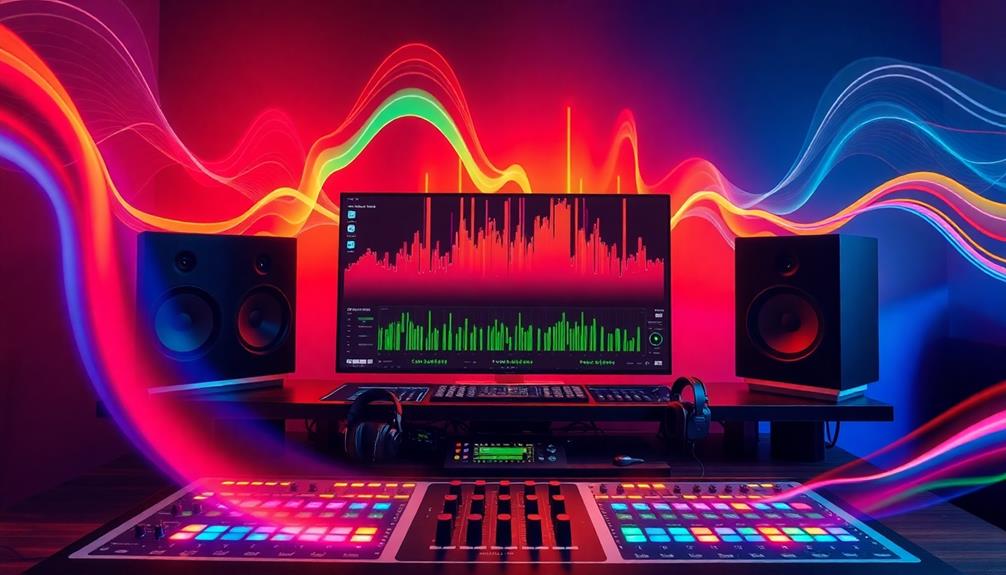
To create a rich and immersive trap beat, you'll want to focus on enhancing instrument width through effective stereo imaging techniques.
Start by experimenting with panning and carefully placing elements across the stereo field, which helps maintain clarity and avoids any one sound overpowering the mix.
Don't forget to regularly check for phase cancellation issues, especially when you're applying stereo effects, to guarantee your mix translates well across various playback systems.
Enhancing Instrument Width
While creating trap beats, enhancing instrument width can greatly elevate your mix, making it feel more expansive and immersive.
Here are three techniques to help you make the most of stereo widening:
- Use Stereo Widening Plugins: These tools can enhance the perceived width of individual instruments, adding depth and richness to your mix. They'll help you make your sounds feel more dynamic.
- Experiment with Subtle Delays: Applying slight delay effects on certain instruments creates a sense of space, pushing them further back in the mix and adding dimension.
- Implement Mid/Side Processing: This technique lets you control the stereo width of mid and side elements independently, allowing for greater soundstage manipulation.
Remember to regularly check your mix in mono to avoid phase cancellation, ensuring clarity and punch in your final track.
Panning Techniques Overview
With a solid understanding of enhancing instrument width, it's time to explore panning techniques that can further refine your trap beats. Effective panning enhances the stereo image by distributing sounds across the left and right channels. For instance, panning instruments like hi-hats and percussion slightly to one side (10-30% left or right) can add width without introducing phase issues.
When you're working on your mix, regularly check it in mono to verify that all elements remain coherent and don't interfere with each other. This helps you maintain a solid low-end foundation by keeping bass elements, like 808s, centrally panned. Higher frequency instruments can then occupy the stereo field more freely.
Using automation for panning adds dynamic movement to your mix, keeping listener interest alive throughout the track. Here's a quick reference table for panning techniques:
| Panning Technique | Description |
|---|---|
| Hi-Hats and Percussion | Pan 10-30% left or right |
| Bass Elements | Keep centrally panned |
| Automation | Introduce dynamic movement in panning |
Avoiding Phase Cancellation
Phase cancellation can greatly affect your mix, especially in the low frequencies where it often becomes most noticeable.
To guarantee your trap beats have that punchy, spacious mix you're after, here are three tips to keep phase issues at bay:
- Monitor in Mono: Regularly check your tracks in mono. This helps you identify any problematic frequencies that may interfere with each other, allowing you to make necessary adjustments.
- Layer with Variations: When layering sounds, avoid using identical signals. Slight variations in timing or pitch can considerably reduce phase cancellation effects, keeping your drum busses powerful and clear.
- Use Phase EQ: Implement phase EQ techniques to correct any phase issues. This can enhance the clarity of your mix and guarantee that all elements work harmoniously together.
Bass Enhancement Methods

To enhance the impact of your trap beats, focusing on bass enhancement methods is important. Start by employing EQ to cut unnecessary low frequencies below 30Hz from your 808s. This guarantees they add depth without muddiness, allowing the kick and snare to shine through.
Next, consider introducing saturation to your 808s using saturation plugins. This adds warmth and upper harmonics, enhancing their presence in the mix without overpowering other elements.
An essential technique is sidechain compression. By allowing the kick to momentarily reduce the volume of the 808, you create space and emphasize the punch of the kick in your mix. It's critical to monitor headroom levels carefully; make sure that your bass elements, especially the 808s, remain 3-4dB quieter than the kick when soloed. This helps maintain clarity and prevents distortion.
You can also experiment with layering bass sounds to create a fuller and richer texture. Just be sure that these bass elements are cohesive and complement the rhythmic foundation of your track.
Implementing these bass enhancement methods will elevate your trap beats to new heights.
Overall Mixing Workflow
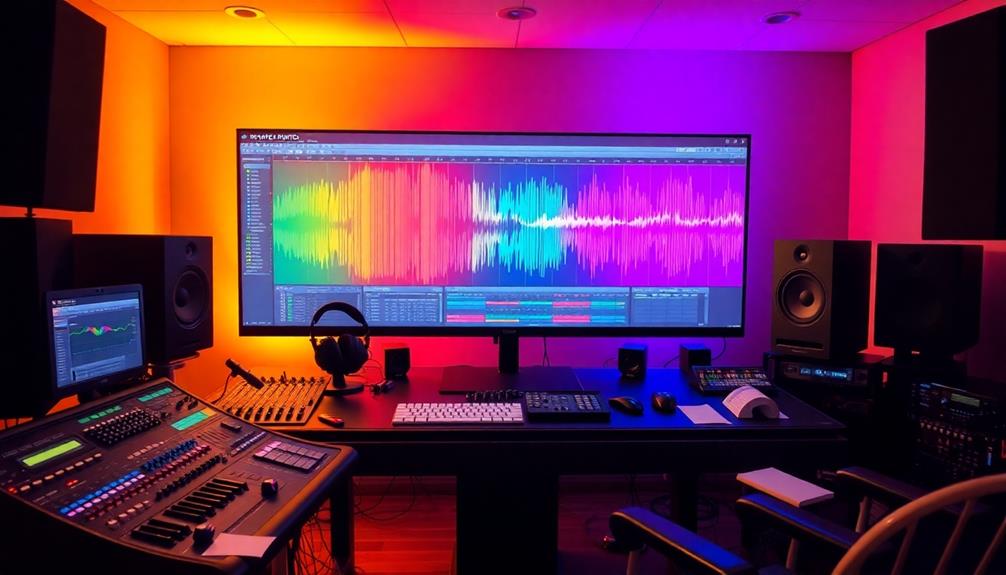
After enhancing the bass in your trap beats, it's time to focus on the overall mixing workflow. This step is essential for creating a polished sound that stands out. Here's a streamlined approach to get you started:
- Set Your Levels: Begin by adjusting the levels for each track, keeping them around -10dB. This helps maintain headroom and prevents clipping, allowing for effective dynamic processing later on.
- Utilize EQ: Carve out space for each element in your mix. Focus on cutting problematic frequencies and boosting where necessary to enhance clarity and punch in your drums and other instruments.
- Apply Compression: Use compression to control the dynamics of individual tracks. This guarantees your overall mix stays consistent and cohesive throughout the arrangement, making every element sit well together.
Don't forget to incorporate stereo imaging techniques as well. Panning and widening effects can enhance the spatial quality of your mix.
Frequently Asked Questions
How Do I Make My Trap Beats Better?
To make your trap beats better, focus on balancing your mix, layering sounds effectively, and using sidechain compression. Don't forget to reference professional tracks and experiment with EQ to enhance clarity and impact.
What Does Every Trap Beat Need?
Every trap beat needs a thunderous heartbeat, echoing with power. You'll want a punchy kick, a distorted 808, crisp snares, and bright hi-hats, all woven together to create a vibrant, engaging sonic tapestry.
What Is the Best BPM for Trap Beats?
The best BPM for trap beats usually falls between 130 and 170. If you settle around 140 BPM, you'll achieve that perfect balance, allowing for energetic hi-hat patterns and heavy basslines that define the genre.
How to Structure a Trap Beat?
To structure a trap beat effectively, you'll want to create distinct sections like intro, verse, and drop. Use dynamic changes and memorable hooks to keep listeners engaged while maintaining energy throughout the track.
Conclusion
As you wrap up your mixing journey, picture your track like a vibrant city at night—each element shining in its own spotlight. By blending your kick and 808, enhancing snares, and mastering frequency management, you've crafted a soundscape that pulses with energy. Trust your ears, keeping levels balanced while letting bass resonate like a heartbeat. With your workflow streamlined, your trap beats will reverberate through the speakers, igniting the dance floor and capturing listeners' hearts.






